

Gordon King, Animal & Poultry Science, University of Guelph
Pigs and their farm role changed dramatically during the past fifty years. During the first half of the 20th century, the pigs found on most farms were primarily a waste disposal system that contributed the occasional meal and even less freq uent revenue. Scavenger pigs still abound as part of a mixed, subsistence farming system in almost all of the less developed countries. Now, however, these often exist in close association with large, specialized units producing for both local and export markets.
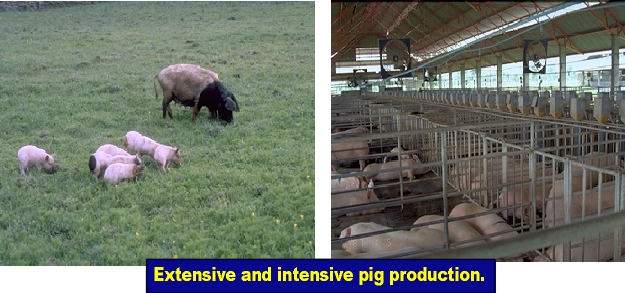
As indicated in the following chart, pork production currently leads all other meat outputs by a considerable margin. Based on the volume of product marketed, pigs, either as part of mixed farming operations or in specialized units, comprise the major livestock enterprise throughout the world.
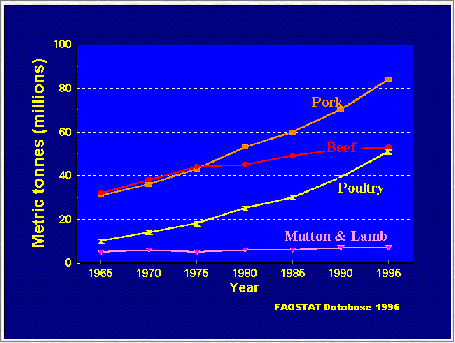
All of our domesticated pigs probably descended from the Eurasian wild boar with major sites of development in both the middle east and in China. Many generations of selective breeding produced the conformation found in our modern breeds. Some of the m ore common breeds in Canada and throughout the rest of the world today are the Yorkshire or Large White, Landrace. Duroc and Hampshire. Check the Oklahoma State agricultural library for inform ation on specific breeds of pigs.
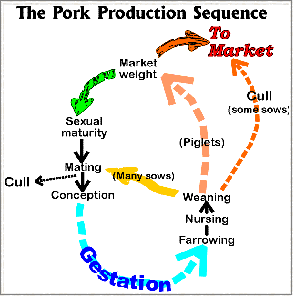
Pigs breed at all times of the year so pork production is a continuous cycle. Traditionally, sows farrowed periodically, piglets were retained after weaning around eight weeks of age, grew slowly, and were consumed eventually or sold by their original owners. Now pigs may constitute the only type of livestock present on a farm with the system often further specialized by operators concentrating on specific stages of the production sequence.
Some farms still keep and mate sows, farrow the liters and raise piglets to market weight. These are called farrow to finish operations. Other farmers engage in weaner production, maintaining breeding herds but selling all their piglets at around ten weeks of age to some other farmer. Those who keep no breeding animals but purchase all of their pigs from weaner producers are called finishing or feeder operators. The pig finishers or fe eders then takes care of these purchased animals until they reach market weight. Regardless of the type of operation, all hog farmers must arrange for appropriate facilities and care to look after their stock. In addition to the moral obligation to provid e humane care, producers recognize that their livelihoods depends on creating an environment that keeps animals healthy and comfortable so they can express their full genetic potential. Careful and conscientious management is essential for ecologically fr iendly and profitable production so it benefits the pigs, the producers and all of society.
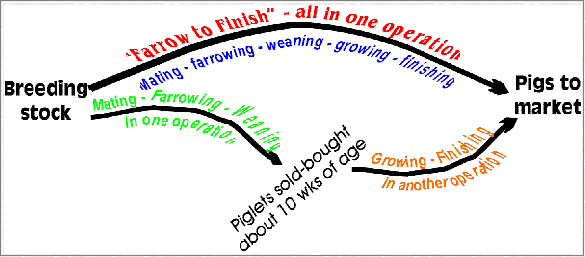
Heritability is the expected response of a trait or characteristic based on the parents' genetic merit (ie. their breeding value or ability to transmit the trait to offspring) rather than the effect due to environmental factors. Heritability is most of ten expressed as a decimal or percentage. For example, the heritability of backfat thickness is about 0.5. This means that approximately 50% of the difference in backfat between individual animals is due to genetics while the remainder results from non-ge netic (environmental) factors. Similar quantitative traits like milk production, growth rate, feed efficiency and other aspects of carcass quality also have reasonably high heritability so respond quickly to genetic selection. In contrast, the environment al factors are considerably more important in traits like fertility or litter size so, in addition to genetic selection, other methods are necessary to improve these characteristics.
The goal of any genetic improvement program is to increase the economic value of the progeny. Requirements for a successful outcome are:
Methods for Assessment of Potential Genetic Worth
Superior performance resulting from good management does not automatically repeat in the next generation whereas that obtained from genetic superiority will be transmitted to progeny. The key to obtaining genetic improvement is distinguishing between t he genetic and environmental factors influencing performance and selecting only those animals that are genetically superior as parents of the next generation.
Estimated Breeding Value (EBV). An EBV is the estimated genetic worth of a particular animal for a specific trait. EBV=s are calculated from performance records of individuals and progeny.
Selection Index. Once selection priorities are decided, it is useful if the EBV information for the various factors can be combined into a single index based on the relative economic values, heitabilities and any correlations between them. For maximum usefulness, any selection index should be updated regularly with new information and adjusted for any changes in economic importance of particular traits.
Factors Affecting Rate of Improvement
Animals of known ancestry (pedigreed) always used in all parts of the breeding program from which any replacements would be kept.
This involves mating animals of different recognized breeds (or strains?) to exploit the strengths of each (complementarity). Crossbreeding also exploits the phenomenon of heterosis, an increase in productivity of the crossbred over and above the avera ge of breeds or lines that are crossed.
Within line selection to improve specific traits. Any attempts to influence genotype, particularly for poly-genic traits, is difficult, time consuming and expensive. This is an obvious method for use within purebred herds since they must demonstrate im provement to remain competitive. If herds are not selling breeding stock, they may still retain pure lines but the expense of purebred registration is not likely to be justified. Because of the costs involved, this approach is becoming more and more conce ntrated within large and often multinational breeding companies.
Producers should always be aware of what is happening elsewhere. This allows rapid introduction of new lines already improved in other locations.
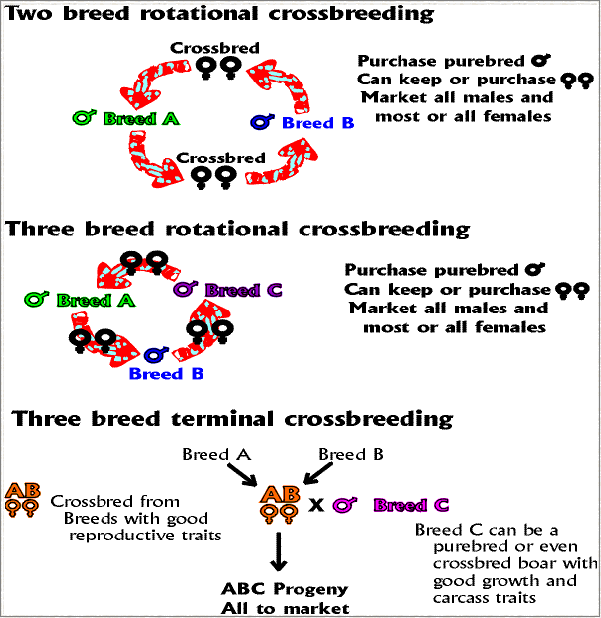
Successful production requires animals with good genotype for traits of economic importance plus the ability to withstand reasonable degrees of stress while maintaining high voluntary feed intake and feed conversion efficiency. Pig farmers may obtain s uch animals from within their own herd or purchase them from other suppliers. The optimum genotype varies with market demand. Asians and Italians still prefer some fat on their pork but Germans and French want none. Canadians and Americans are somewhere i n between these extremes.
Healthy pigs without the proper genotype may not always be profitable pigs but unhealthy pigs cannot be profitable regardless of genotype. Hybrid vigor and vaccinations aid in maintaining good health but provision of a satisfactory environment is even more important. This is particularly true in the nursery area since recently weaned piglets are the most susceptible to disease. People operating growing-finishing units should be very careful where they obtain their stock since it is much easier to keep disease out than it is to eliminate it once an infection gets started. An all-in all-out system is best. Farmers forced into continuous production should isolate all new additions for a period before entrance to the main herd.
Pig husbandry follows several patterns. Throughout those regions of the world where subsistence farming predominates, pigs usually roam freely, rooting or scavenging for whatever feed they can find for themselves. Such scavenger pigs must be prevented from foraging in gardens or grain plots during the active growing seasons. Also, some form of constraint is necessary at night if attack by predators or theft might occur. Pigs in the industrialized countries are usually confined throughout most or all of the production cycle. Some form of pasture feeding, often combined with open-fronted shed housing, may be incorporated into the confinement systems whenever climate and land availability allow.
The pork production sequence can be divided into five phases; mating, gestating, farrowing, nursery and growing-finishing. Animals have specific needs at each of these stages, requiring appropriate husbandry and facilities to insure that they receive p roper attention and care. Although specific housing varies considerably between regions and even between farms within regions, all animal housing should be constructed to look after the well being of the pigs and their attendants.
The comfort zones and management requirements change substantially throughout a pig's life. Modern units are designed to allow convenient movement of animals to appropriate quarters as their needs change during the production sequence from birth to market or during the reproductive cycle. The design goal is to provide the best possible environment for both pigs and people. Obviously, this must be done within some economic constraints.
Extensive or systems with animals running outside whenever possible requires less capital and perhaps management expertise but they are labor intensive whenever animals must be moved or handled in any way.
Confinement housing is capital intensive for both buildings and equipment but provides opportunity for automation and labor reduction. Proper operation of these systems demand considerable management expertise. Our pig buildings fall into two main clas ses:
Special areas must be provided for animals in various stages of the production sequence.
Calculate the Pen-Cycle:
Pen-Cycle = [(filling crates in room = x days) + (nursing period = x days) + (cleaning period = x days)]
Pens needed = [No. of sows x litters per sow per year x pen-cycle ÷ 365]
In conjunction with any housing areas, pig units require facilities for moving, handling and restraining pigs of various sizes.
|
Conception - birth |
114.5 ± 3.5 days |
Suckling period |
7 to 35 days |
|
Starting period |
weaning to 90 days |
Growing - finishing |
90 to 220 days |
|
Age at puberty |
140 to 240 days |
Age at 1st mating |
190 to 280 days |
|
Estrus cycle length |
16 to 22 days |
Estrus period duration |
24 to 72 hours |
|
Reproductive life |
3 to 8 years |
Maximum productivity |
2 to 4 years |
Many sows come into estrus about 4 to 7 days after weaning (range for most sows is 3 - 10 days but 1st litter gilts may take longer). Thus, producers with large herds usually try to wean on Thursday so that many sows show estrus and require mating on the following Monday to Thursday. This reduces, but does not eliminate, the need for weekend mating chores.
Additional information is available on mating management and farrowing.
Newborn piglets have very limited ability to digest feed. The sow compensates for this by producing milk, a readily digested diet supplying almost all the nutritional requirements of her offspring, and offering this frequently. Also, the immune system is immature at birth so piglets have no inherent resistance to disease and cannot generate any real protection for five or six weeks. Antibodies concentrated in sow colostrum compensate for this initial deficiency but protection is short and usually has d isappeared by weaning time (ie. in 3 to 5 weeks). Weaning, particularly at younger ages, involves a sudden change of diet and environment, so is certainly one of the most potentially distressing stages in a piglets life.
Click for additional information on weaning.

Growth is an anabolic process resulting in an increase in body mass over a period of time. The enlargement in body size of domesticated animals, taking place throughout the period from conception to maturity, is the basis of meat production. Growth occ urs in two ways, through an increase in cell numbers (hyperplasia) or an increase in cell size (hypertrophy). Neither the whole body mass nor its individual tissues an organs grow at exactly the same rate so growth is asynchronous. One of the major challe nges in livestock production is deciding when is the optimum time to market animals. Since feed efficiency declines as the growth rate slows, making the correct decision on when to market is often the difference between profit and loss.
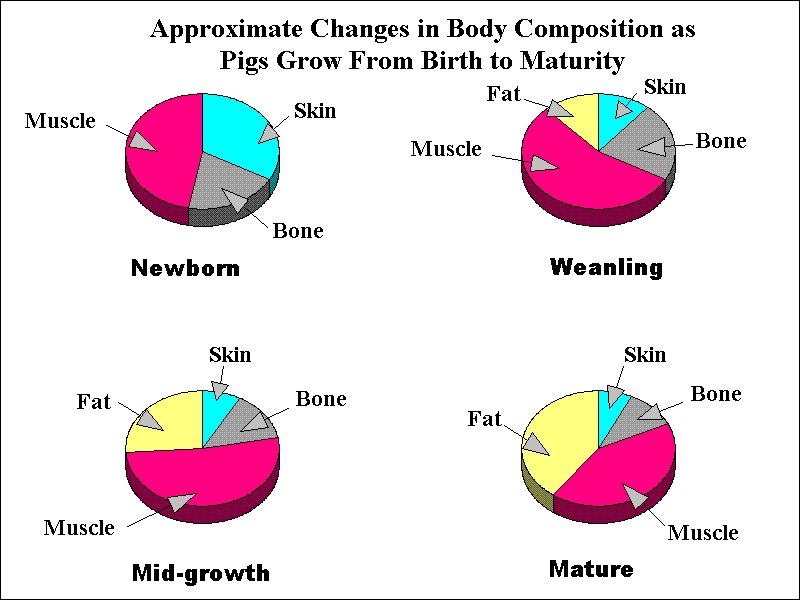
The progressive changes in body shape, size and chemical composition occurring between conception and full maturity result in both structural and functional changes in the constituent parts. These pertain to the stage of physiological maturity and rela te to product quality. The natural growth process favors development of muscle tissue throughout much of the growing-finishing period. As animals near their fully mature body size, however, the natural tendency is to reduce muscle and increase fat deposit ion. Producers generally try to market them just before or very shortly after this transition.
Growth can be manipulated by injection of recombinant porcine somatotrophin.
There is considerable disparity in recommendations on space requirement for growing and finishing pigs. Up to a point, the more space - the better the performance. All housing is a compromise between maximizing performance of each pig in a pen and opti mizing the financial return from investment. Whenever housing costs are low and feed is expensive, operators can be more liberal with space allowed per pig. In many confinement units, groups start out with considerably excessive space and grow into it. Us ually, they finish with a slight deficiency but, since the largest animals are soon marketed, the crowded situation should not persist.
Less floor space is necessary with ample feeding and watering facilities since competition is minimized or eliminated. In contrast, more space per animal is necessary with higher ambient temperature or if ventilation may not be adequate during the hott er summer months.
Ideally, sexes should be penned separately.
Pigs can also be grown and finished outside.
Diets for growing pigs from 20-50 kg should contain 18% protein. The protein content can then be reduced to 16% for animals up to market weight. Properly formed pellets are preferred since they reduce dust and wastage. Pellets also flow easily through automated feeding equipment.
Full Feeding
Restricted Feeding
Wet Feeding System
For some additional information on diet formulation and ingredients go to the accompanying section on Feeding Pigs.
Raising healthy livestock should be both aesthetically and financially rewarding, but keeping unhealthy animals is almost never profitable or satisfying. Current knowledge and technology, when combined with sound management, should result in very low i ncidence or even elimination of most diseases. Unfortunately, even though most producers are aware of this point, some still seek magic panaceas rather than committing to the provision of proper housing, sound nutrition, scrupulous sanitation and appropri ate vaccinations.
Some general recommendations for sound management and disease prevention are:
When vaccinating or injecting pigs, always administer the material into the neck muscles rather than into the ham or rump regions. If bruising, scarring or abscesses should occur, these will result in trimming loss of a less valuable portion of the car cass.
Check the Swine Care Handbook prepared by the National Pork Producers Council for additional information on management, housing, feeding, herd health and producer responsibilities. The NPPC also provides access to a considerable amount of other useful information relating to pigs.
Some other potentially useful links for information on pigs:
Ontario Swine Improvement Inc.
Canadian Swine Breeders Association